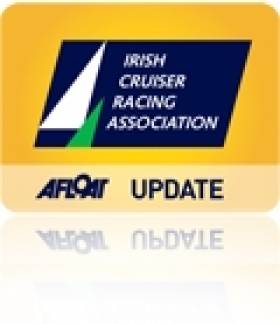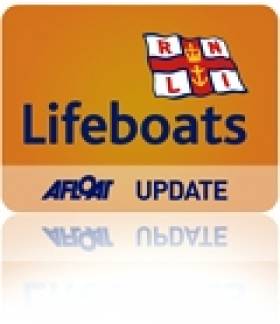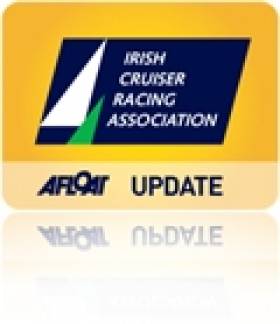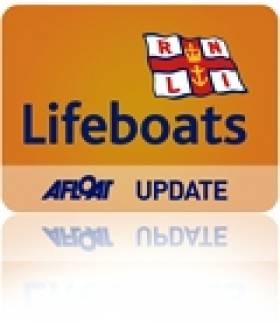Displaying items by tag: Fenit
Kilrush RNLI Lifeboat In Multi-Agency Search Operation
#lifeboat – Lifeboat crew launched early this morning to take part in a multi agency search and rescue operation involving Kilrush and Fenit RNLI, Coast Guard rescue teams from Kilkee and Doolin.
At 3.29am Shannon Coast guard tasked Kilrush RNLI volunteer lifeboat crew to investigate a report of four persons in the water in the Poulnasherry Bay area of the Shannon Estuary.
Kilrush lifeboat crew were met by members of the public on the scene who had successfully recovered three persons safely from the water. The casualties were transferred by ambulance to Limerick Regional Hospital. Kilrush RNLI, Kilkee Coast Guard and the Shannon based Coast Guard helicopter undertook a large-scale search of the area to locate a fourth missing person.
The search operation continued through the night with the addition of Fenit RNLI lifeboat, Doolin Coast Guard, Irish Customs Vessel, Ballybunnion Rescue Services, SFPC Pilot Boat as well as an extensive shore search team from all agencies as well as navy diving units.
A person was recovered from the water at 10.42am following an extensive search.
Commenting on the callout, Pauline Dunleavy, Kilrush RNLI Lifeboat Operations Manager said: 'This was one of the largest search and rescue operation in the Shannon Estuary for a number of years. I would like to commend the quick response from all agencies especially the members of the public that assisted. On behalf of everyone at Kilrush RNLI Lifeboat Station, I wish to express our sincere condolences to the family and friends of the man who sadly did not survive.
#Sailbot - The Canadian engineers behind the latest robotic boat challenger to cross the Atlantic unaided have told The Sunday Times' Gabrielle Monaghan about their hopes for the project this summer.
As previously reported on Afloat.ie, the team from the University of British Columbia will put their 'sailboat' to sea from Newfoundland in August, bound for Ireland in the latest attempt at the Microtransat Challenge.
No previous attempt has been able "to even cross the halfway point," said UBC Sailbot team co-captain Kristoffer Vik Hansen.
But reaching Fenit - which stepped into the breach when previous destination Dingle proved a no-go due to tourist traffic - would be the dream come true for the 66-strong team of students bringing together the complementary disciplines of engineering and computer science.
Indeed, it would also mark a retracing of the route of St Brendan the Navigator's legendary voyage from that Co Kerry town to Newfoundland some 1,500 years ago.
ICRA Feeder races from Dublin bay, Galway bay and the Shannon Estuary, some with early starts to avail of favourable tides are planned for early June all to arrive in good time for the Fenit based National Cruiser Championships.
The Dun Laoghaire to Dingle (D2D) race starting on Friday, June 7th from Dublin Bay has over 20 boats entered so far. Significantly entries are ranging on IRC handicap points difference from .898 to 1.144 and maybe higher, so there will be a well spread fleet going down the east coast of Ireland on June 7th.
A favourite west coast feeder is the O'Sullivans Marine 100–mile race. This annual fixture is planned to leave Galway docks at 20.00 also on Friday, June 7th for an over night race into Fenit marina the following day and is billed as ideal for ICRA boats coming from Sligo, Mayo, Clifden.
ICRA Class Two is One to Watch at Tralee Bay Championships
#icra – ICRA Class 2 is building to become the strongest class and most widely representative of all coasts at June's ICRA Nationals at Tralee Bay SC writes Barry Rose.
With entries already received from likes of Paul and Deirdre Tingle from Royal Cork who are bringing their new Corby 25 Alpaca (ex Allure ex Kinetic) a boat with a terrific reputation at ICRA Nationals.
The Tingle's will be taking on fellow Corby 25 Tribal (ex Yanks and Franks) Liam Burke from Galway Bay and Ray Mc Gibney's Disaray from Foynes Yacht Club and Strictly Business (Ferguson Kelleher) from Tralee Bay.
King One Dave Cullen's Half Tonner from Howth Yacht Club will travel together with Nigel Biggs Checkmate XV from Royal St George to lead a Dublin Challenge.
Egalite David Griffins Dehler 34 from Cliften will likely be joined by Martin Reilly's Half Tonner Harmony (also originally optimised by Nigel Biggs) and Conor Ronan's well prepared Corby 26 Ruthless both from Sligo Yacht Club.
It is also hoped Royal Cork Admiral Peter Deasy and his team on Bad Company will compete to build on their success at Cork Week.
Class 0 already has the likes of Norbert Reilly's Mills designed Crazy Horse sailing this time with a father and son combo and Conor and Denise Phelan's Ker designed Jump Juice being joined by Anthony O'Leary's Ker 39 Antix and George Sisk's Wow so the basis of a most competitive fleet is also building nicely in this class.
Priority berthing in Fenit Marina will be given to early bookings.
Update from Brian O'Sullivan at Tralee Bay SC
1. April 27th: end of early entry discount.
2. IRC and ECHO Certificates: have you got your certificates sorted out, or
even applied for at this stage? this process can take several weeks, so make
sure you get your application in as soon as possible....
3. Accommodation: There are still some houses available for letting at very
reasonable rates in Fenit village, but they are getting scarce. The
committee have sought out whatever is available and the last few houses will
be listed on the website very shortly, so keep an eye on this. Don't forget,
the Brandon Hotel also, have a few rooms left at unbelievable rates - check
out our website for details - www.traleebaysailingclub.com
4. Crew: for owners and skippers - it is time to get your crew together. Get
some early training in, get rid of the cobwebs and build up some team
spirit. Only 8 weeks to go!!!
5. Boat Movements: if you have to bring your boat to the event - have you
lined up a delivery crew and a return trip crew? Time to organize this now -
make sure you have plenty crew, as inevitably, some will drop out in the
last minute for whatever reason! If you are struggling to get crew, contact
us and we will help from our pool of skippers and crew who have volunteered
for these delivery trips. Email us on [email protected] for
details.....
6. June 12th: WIORA commences...........
7. June 13th: ICRA commences............
Guys and girls: start getting your ducks in a row!!!!! Get entries with
PAYMENT in to avail of priority berthing in Fenit Marina!!!!
Fenit RNLI Bid to Save Stranded Dolphin
#rnli – Lifeboat crew with Fenit RNLI and three local families worked together last night (Tuesday 26 March) to save the life of a stranded dolphin in the Kerry town. The mammal was running out of time after he was washed up into a deserted channel on a remote beach on Fenit Island and was not able to return to the water.
In a rescue operation that involved members of the Egan, Tobin and McCarthy families, three RNLI volunteer lifeboat crew, an inshore lifeboat and a jeep, the dolphin was given a fighting chance and was safely deposited by the lifeboat crew out in deep water.
The drama began when local woman Breda McCarthy was out walking her dog on Fenit Island when she came upon the stranded dolphin. It was lying in a small channel quite a few metres from the sea. It is believed the dolphin had swam in at high tide a few hours earlier and had got cut off from the sea. Mrs McCarty contacted family members who came down to see if they could return the dolphin to the water. Unfortunately this was not possible as the mammal kept to the shallow waters and would not return to the sea.
With their concern growing the families contacted Ger O'Donnell, Fenit RNLI Lifeboat Operations Manager to see if the RNLI could assist them. Ger in turn made contact with Valentia Coast Guard who put him in contact with a dolphin expert. After discussing the situation with the expert it was decided that the best course of action for providing a safe outcome would be to transport the dolphin down to the harbour and then transport it by RNLI lifeboat out to sea to be released.
The dolphin was carefully wrapped up and transported by jeep to the harbour where RNLI lifeboat crew were already waiting in the inshore lifeboat to launch. They took the dolphin onboard the lifeboat and proceeded immediately out to sea. On releasing the dolphin into the water the lifeboat crew watched as the mammal slowly started to swim around the lifeboat in ever increasing circles, gaining confidence as it went. Once they were satisfied the dolphin was able to safely swim away, the lifeboat crew returned to shore.
Commenting on the unusual callout Fenit RNLI Lifeboat Operations Manager Ger O'Donnell said, "This was not your run of the mill rescue for the lifeboat crew. We were very anxious that we did everything right and gave the poor thing the best chance of survival. I want to thank everyone involved. It was a real community effort, from the local families, the RNLI crew and the Coast Guard, who were able to put us in touch with the expert advice we needed. It was almost as if the dolphin knew we were working to save him and I sincerely hope that he made it and we can count him as another life saved."
Local woman Mary Tobin, whose son Michael captured some photos of the incident said, "It was great to see everyone working together. I can't thank them enough, we were so worried the poor creature was not going to make it. When my sister Breda found him it was clear that he was in a bad way and his breathing was very laboured. We knew that with the RNLI on our doorstep that we would have a good shot at a successful outcome.
#icra – A fleet of 40 boats with some high calibre entries are entered so far for the ICRA National Championships at Tralee Bay Sailing Club in June.
This year organisers says there is equal focus on IRC and ECHO handicaps in the National Championships with equal trophies prizes and recognition together with the ICRA Corinthian Cups for the Non-Spinnaker Divisions means that all Club sailors are catered for say organisers.
Division 2 is already shaping up to be a great fleet with the Corby 25 Tribal (ex Yanks and Franks), Liam Burke from Galway Bay entered and Dave Cullen's Half-Tonner King One from Howth Yacht Club. Nigel Biggs' Half-Tonner Checkmate XV from Dun Laoghaire's Royal St George is also in. There are also expected entries from skippers Frank Desmond, Peter Deasy and Mark Ivor's Cork Week winning Bad Company from the Royal Cork and Martin Reilly's Half-Tonner Harmony from Sligo Yacht Club.
Division 3 already has two hot quarter tonners Diarmuid Foley's Anchor Challenge from the Royal Cork and Lostys Illes Pitituses from Cobh Sailing Club as well as the defending champion Tiger (Neil Kenefick).
Division 1 is also building with likes of Raptor Denis Hewitt and partners and Joker 2 John Maybury both from the Royal Irish Yacht Club and Exhale Derry Good from Royal Cork Yacht Club leading the charge.
Division 0 sees ICRA Commodore Norbert Reilly's Crazy Horse Howth Yacht Club lining up against Anthony O' Leary's Royal Cork Antix who will be using the Dun Laoghaire to Dingle race as a feeder. Gloves Off skippered by Kieran Twomey and Conor Phelan's Jump will also be likely to travel from Royal Cork.
The ICRA Corinthian Cup will be sailed for non spinnaker classes at the same time and is expected to draw significant interest.
As before in Tralee, WIORA West Coast Championships is 'intertwined' with the ICRA's and starts a day earlier on 12th finishing on the 14 th as an extra bonus for all those who travel.
The facilities of Fenit Harbour including marina berths for the duration of the event together with inexpensive lift in and out are a bonus for ICRA. TBSC promise a carnival atmosphere in the club and throughout the village with pubs and restaurants doing their bit to make sailors welcome.
Entry discount applies before 27th April 2013 so don't delay - get your entry in now at www.traleesailingclub.com
ICRA Nationals 2013; Tralee Bay Sailing Club, June 13 - 15th
#icra – A series of feeder races to Kerry for the 2013 Irish Cruiser Racer Association (ICRA) Nationals at Tralee Bay Sailing Club (TBSC) could swell numbers to 70 boats or higher for the Fenit event according to estimates coming from ICRA's annual conference in Kilkenny on Saturday. PDFs of the Notice of Race, entry form and event advert and flyer are available for download below.
The major event for Fenit Bay next season will be preceded by the WIORA West Coast Championships (June 12 - 14th 2013) and as both events will be staged in the same week along with a shore based family based Sea Breeze festival, the Kingdom is preparing for a big celebration of sailing 'craic' next Summer.
TBSC are also aiming to contribute to 'The Gathering' initiative by inviting overseas crews to sail back home for a racing week in the most westerly port in Europe.
Championship organiser Brian O'Sullivan previewed the June 13-15 event for the ICRA delegates on Saturday and there was a lively discussion on making the national championship a no-discard event as well as writing new alternative on the water penalties into this year's sailing instructions.
O'Sullivan confirmed feeder races will include the Dun Laoghaire to Dingle (D2D) race (June 8th) with D2D race organiser Martin Crotty offering to accommodate as many ICRA racers for the 180–mile race from the National Yacht Club. Races from Galway and Cork have also been designed to encourage as many boats as possible to head west.
Estimates indicate that a 40-boat WIORA fleet will be supplemented by at least 30 or more Dublin and Cork visitors giving respectable championship fleet sizes.
Although ICRA and Fenit organisers concede the remote location from the big Dublin cruiser fleets might be an obstacle on reasons of cost in the current climate, the decision is nevertheless in keeping with ICRA's ethos of sharing the championships around the coast on a yearly basis. (The next championships is scheduled for Dun Laoghaire at the Royal Irish YC in 2014).
Course types were also discussed on Saturday. Research from the 2012 ICRA championships in Howth showed cruiser racer fans are split on course types. Some favour windward leeward courses but others are keener on round the cans course configurations. International Race Officer Alan Crosbie will lead the race management team on the water.
A mix of courses produces more accurate results under the IRC handicap rule and as there appears to be a ground swell away from pure windward-leeward courses the intention in Fenit is to run three separate course types over the two seven race WIORA and ICRA series from Brandon Point to Kerry Head.
'Reconnaissance' Wins Fenit to Dingle Race
Peadar O'Loughlin's Sigma 33 Reconnaissance was the overall winner of Tralee Bay Sailing Club's race from Fenit to Dingle this October but only after a great comeback in the last two miles of this County Kerry race.
The first boat in was Galileo, with Reconnaissance hot in his tail and Jaguar not far behind either, with Rooster coming in shortly afterwards. Abandon Office, Powder Monkey and Ridire Ban (previous class winner in Dun Laoghaire - Dingle race) retired. On corrected time, first place in IRC went to the Sigma 33
-Reconnaissance, having made a great comeback to steal it from Jaguar in the last two miles.
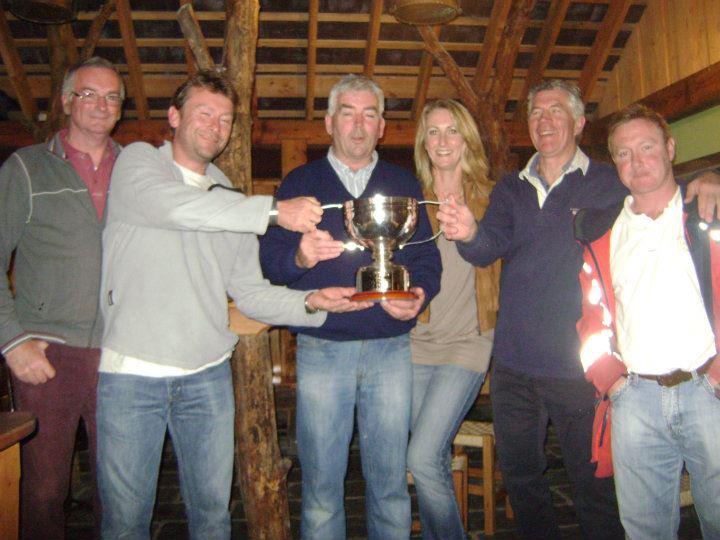
Lifting the O'Connell Cup, the last feature race of the Tralee Bay Sailing Club season. The Cup was Sponsored by Finbar O'Connell Jewellers, Tralee and was won by Reconnaissance, a Sigma 33, owned by Peadar O'Loughlin and crewed by Brian O'Sullivan, Frances Clifford, Fergus Kelliher, Kieran Kelliher, John O'Mahony and Eoin Nolan.
This was the last feature race in the 2011 Tralee Bay Sailing Club calendar. The October series continues 'til the end of the month, and an End of Season Party will be held on the last weekend of the month, after racing that day.
Bannon Takes Record Sixth Mermaid Title
After four different race winners (5 including the void race which was resailed) there with three potential overall winners going into the last race. The championship had its usual controversies with one race being deemed void after a rule 66 rehearing of a protest for redress. There were 33 entries from the usual Mermaid strongholds.
The top 3 were:
1st Endeavour 102 Roger Bannon National Yacht Club
2nd Tiller Girl 77 Jonathan O Rourke National Yacht Club
3rd Innocence 188 Anthony Carty Rush Sailing Club
The 80 year old class is not steering shy of new technology. Class techie Peter Scallan organised multiple live blogs on a special web site which provided live updates and photos during every race. http://www.dublinbaymermaid.org and http://www.dublinbaymermaid.org/fenit2011
RNLI Appeals for Donations to Ensure Its Survival
The Royal National Lifeboat Institution (RNLI) has issued an appeal for funds to ensure its survival.
The volunteer crews from the RNLI go to sea hundreds of times a year to help those in danger off the Irish coast, often in terrible conditions.
One recent rescue reported on Afloat.ie saw the Fenit inshore lifeboat launched to go to the aid of a fishing vessel in Tralee Bay having difficulties in thick fog.
The lifeboat successfully found the disorientated oyster fishing boat, with three crew members aboard, then discovers two further oyster fishing boats also struggling in the fog. All three were escorted safely back into the harbour.
The last two years were the busiest in the RNLI's history, the organiation says, but income is in danger of not keeping pace.
Last year volunteer-crewed lifeboats rescued 813 people from the seas around the Irish coastline, They are ready to go to sea whatever the conditions, and are on call 24 hours a day. But they can't do this without your help.
The RNLI is a charity and relies on donations to keep the lifeboat service running. If you can give anything, please forward it to the RNLI Fundraising Appeal, RNLI Ireland, Dept AA1280, PO Box 4214, Freepost, Dublin 2.




























